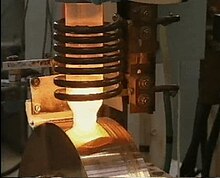

Melt spinning is a metal forming technique that is typically used to form thin ribbons of metal or alloys with a particular atomic structure.[1]
Some important commercial applications of melt-spun metals include high-efficiency transformers (Amorphous metal transformer), sensory devices, telecommunications equipment, and power electronics.[2]
A typical melt spinning process involves casting molten metal by jetting it onto a rotating wheel or drum, which is cooled internally, usually by water or liquid nitrogen. The molten material rapidly solidifies upon contact with the large, cold surface area of the drum. The rotation of the drum constantly removes the solidified product while exposing new surface area to the molten metal stream, allowing for continuous production. The resulting ribbon is then directed along the production line to be packaged or machined into further products.[3][4]
The cooling rates achievable by melt spinning are on the order of 104–106 Kelvins per second (K/s). Consequently, melt spinning is used to develop materials that require extremely high cooling rates in order to form, such as metallic glasses. Due to their rapid cooling, these products have a highly disordered atomic structure which gives them unique magnetic and physical properties (see amorphous metals).[3][5][6]
Several variations to the melt spinning process provide specific advantages. These processes include planar flow casting, twin roll melt spinning, and auto ejection melt spinning.
Originating with Robert Pond in a series of related patents from 1958 to 1961 (US Patent Nos. 2825108, 2910744, and 2976590), the current concept of the melt spinner was outlined by Pond and Maddin in 1969. At first, the liquid was quenched on the inner surface of a drum. Liebermann and Graham further developed the process as a continuous casting technique by 1976, this time on the drum's outer surface.[7] The process can continuously produce thin ribbons of material, with sheets several inches in width commercially available.[8]
- ^ Shirzadi, A. A.; Kozieł, T.; Cios, G.; Bała, P. (2019-02-01). "Development of Auto Ejection Melt Spinning (AEMS) and its application in fabrication of cobalt-based ribbons". Journal of Materials Processing Technology. 264: 377–381. doi:10.1016/j.jmatprotec.2018.09.028. ISSN 0924-0136.
- ^ Hasegawa, Ryusuke (2000-06-02). "Present status of amorphous soft magnetic alloys". Journal of Magnetism and Magnetic Materials. 215–216 (1): 240–245. Bibcode:2000JMMM..215..240H. doi:10.1016/S0304-8853(00)00126-8. ISSN 0304-8853.
- ^ a b Cahn, Robert W.; Haasen, Peter (2014), "Preface to the Third Edition", Physical Metallurgy, Elsevier, pp. xv–xvi, doi:10.1016/b978-0-444-53770-6.05002-4, ISBN 9780444537706
- ^ Budhani, R. C.; Goel, T. C.; Chopra, K. L. (1982-12-01). "Melt-spinning technique for preparation of metallic glasses". Bulletin of Materials Science. 4 (5): 549–561. doi:10.1007/BF02824962. ISSN 0973-7669.
- ^ Voo, N. Y.; Olofinjana, A. O. (2017-01-01). "Multi-stream Casting of Wire Directly from Melt". Procedia Engineering. 13th Global Congress on Manufacturing and Management Zhengzhou, China 28–30 November 2016. 174: 195–205. doi:10.1016/j.proeng.2017.01.204. ISSN 1877-7058.
- ^ Fedsteel (2016-04-20). "What is an Amorphous Metal?". FedSteel.com. Retrieved 2019-10-16.
- ^ Liebermann, H.; Graham, C. (November 1976). "Production of amorphous alloy ribbons and effects of apparatus parameters on ribbon dimensions". IEEE Transactions on Magnetics. 12 (6): 921–923. Bibcode:1976ITM....12..921L. doi:10.1109/TMAG.1976.1059201.
- ^ Egami, T. (December 1984). "Magnetic amorphous alloys: physics and technological applications". Reports on Progress in Physics. 47 (12): 1601–1725. doi:10.1088/0034-4885/47/12/002. S2CID 250756792.